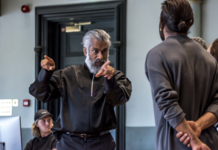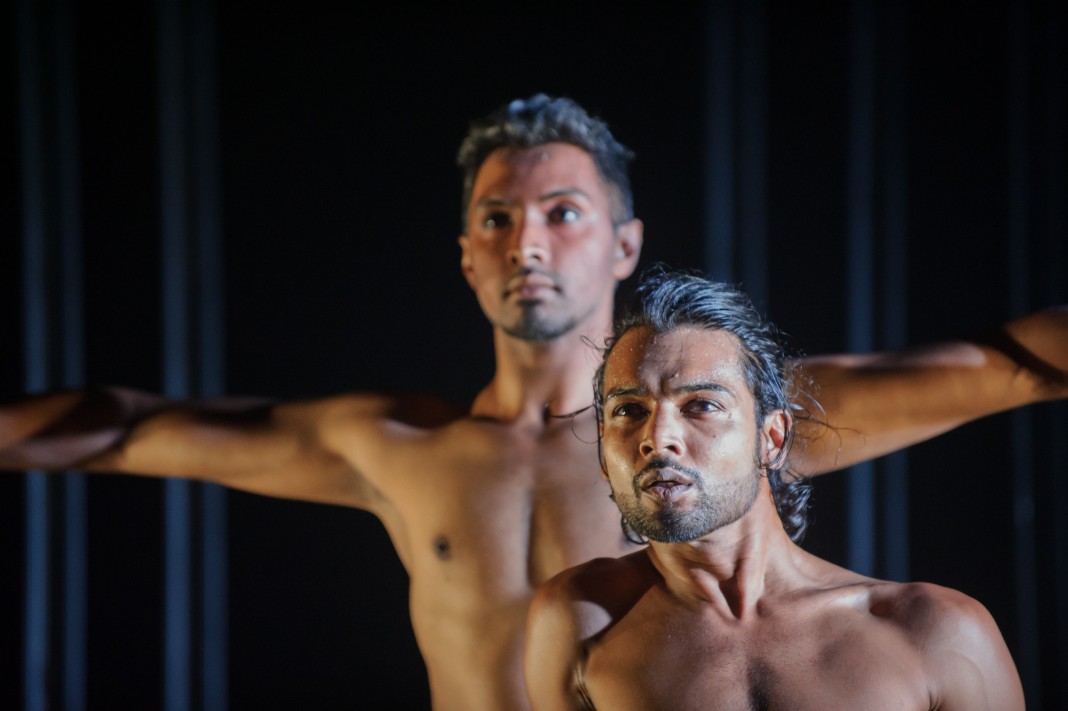Hip hop and classical Indian dance – the two styles could not be more different. But look beneath the surface and you’ll discover a shared history rooted in the dark realities of a past forged by colonial migration, labour and the violence of loss.
It is from this rich and relatively overlooked history that Choreographer Shobana Jeyasingh drew inspiration for her latest pioneering dance work, Material Men redux, which arrives at Birmingham Hippodrome on UK Tour from Mon 27 – Tues 28 Mar.
Described by critics and peers as ‘one of the most exciting choreographers at work in the UK today’, Shobana Jeyasingh has been creating dynamic and enigmatic dance works for over 27 years. Born in Chennai, India and with roots in Sri Lanka and Malaysia, Shobana’s celebrated career has seen her work tour to festivals and venues across Europe, the USA, India, China, South Korea and Hong Kong, taking in settings as diverse as cathedrals, universities, city centres, photo booths and historic church ruins.
With a string of creative collaborators under her belt including filmmakers, mathematicians, digital designers, writers, animators as well as award-winning lighting and set designer, Shobana’s bold and innovative approach to dance saw her twice named Time Out award-winner for Best Choreography and the winner of the prestigious Award for Excellence in International Dance in 2014.
In a year that marks the 100th anniversary of the abolition of Indentured Labour by the British Government, Shobana’s latest work brings together the personal stories of two virtuoso dancers, Sooraj Subramaniam and Shailesh Bahoran – giving voice to a version of British history that exists outside of the mainstream.
A story of shared history, migration and the irrepressible power of the human spirit to forge new ways of belonging, Material Men redux interweaves music, archive film, movement, photography and dance to shine a spotlight on this fascinating story of personal struggle across the cultural divide.
Featuring an evocative film by Simon Daw composed of archive photographic material, and historic texts with score by acclaimed Australian composer Elena Kats-Chernin played live on stage by The Smith Quartet, Material Men redux is a pertinent reminder of a past long-since overlooked in British colonial history, a history made all the more pertinent by the current political climate of mass migration and displacement.
Ahead of the show’s arrival in Birmingham, we spoke to Shobana Jeyasingh about the inspiration behind her new work and the personal testimonies which inspired it.
You made an earlier version of this piece in 2015 – Material Men. Why have you decided to return to it now?
In Material Men I started with the different dance styles that the dancers had chosen (the counterpoint to that was the fact that they were both European Asians). In the course of talking to the dancers I discovered that they both had connections to the indentured labour system of the nineteenth century.
As I continued to understand this really important part of colonial history I realised that I needed more than half an hour which was what the original production was designed for.Did you know, for example, that from 1834 to the end of WWI, Britain transported approximately 2,000,000 Indian indentured workers to nineteen colonies including Fiji, Mauritius, Ceylon, Trinidad, Guyana, Suriname, Malaysia, Uganda, Kenya and South Africa.
Whilst slavery was officially abolished in 1833 in Britain, there was still a great need for labourers in sugar, cotton, tea and rubber plantations. At the same time, British commercial interests in India created famines as they replaced agricultural production with the growing of opium to send to China in exchange for tea. This meant that millions of impoverished peasants were desperate for work and a better life.
Under the false security of a contract, many were recruited to work abroad and were offered a ‘promised land’ with only a vague idea of where they were going.
Duped into being labourers, these indentured workers (known as ‘coolies’) embarked on a perilous journey across oceans – a quarter died at sea – to work and live in very basic settlements, surviving on very little food and money. Only a few managed to save enough money to make the trip back to India. As a result, strong Indian communities, which still exist today, were developed in these foreign lands.
We know it’s about colonial migration and plantation labour. What made you want to base a dance work on this?
It’s a story that I am very interested in personally – it’s about loss, the power of memory and what it means to create yourself anew.
In Material Men the narrative was about the two dancers and their different journeys. In Material Men redux one dancer represents all indentured labourers and the other dancer represents what they left behind.
During the 19th century and at the beginning of the 20th century, millions of Indians were transported to plantations in the British colonies to work in conditions close to slavery.
Sooraj’s grandfather, for example, moved to Malaya (now Malaysia) to work as a supervisor in a rubber plantation whilst Shailesh’s great-grandparents moved from remote Northern India to be labourers in plantations in Suriname, South America.
The dancers play archetypal roles as well as being two men who chose different styles of dance. And the inclusion of historic texts sets the dance in a more political and specific context.
How do you use/transform the dancers’ personal family experiences of these events?
It is mainly Shailesh’s family experience that we hear. His great grandparents did the classic journey from a village in north India to work on the sugar plantations in Suriname.
Material Men redux is also about two men who dance in very different ways, who lead very different lives who nevertheless make a journey towards each other in the course of Material Men redux.
Both dancers perform in their known dance language: Sooraj, for example, trained in classical Indian dance techniques, Baratha Natyam and Odissi, while Shailesh is a hip hop dancer.
Sooraj’s presence reminds us of the persistent memory of India and Shailesh mimics and copies his dance vocabulary. In their duets, they dance together in their own way but connect and come together in echoing movements and in physical contact and intimacy.
How are you working with the two different dance styles of the dancers – classical south Asian and hip hop?
The differences in style are obvious as soon as the dancers begin to move. Sometimes I work with that difference to tell my story, at other times I work with what I see that they have in common – like movement isolation, virtuosity and showmanship.
Simon Daw’s film is a collage of archive footage and images. What sort of thing will we see?
The images that we have chosen are some very early photographs of indentured workers leaving the Calcutta docks, the journey in the boats and the labourers themselves. However, the film is not meant to be illustrative or a documentary. We hope it will be more evocative and capture the experience of those who left India to work as indentured labourers.
This version of the work seems to be more overtly ‘political’, is it influenced by events of the last year or so – the refugee crisis, recent elections and the changing political climate in general?
Migration is a huge issue at the moment and sometimes it’s easy to forget why people migrate. It is a phenomenon that is not unique to us at this time.
I think it is good to know British history from other less mainstream voices. In Material Men redux I hope that we hear such voices.
Material Men redux runs in The Patrick Centre from Mon 27 – Tues 28 March. For tickets, call 0844 338 5000 or visit www.birminghamhippodrome.com


































